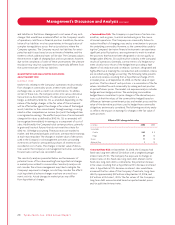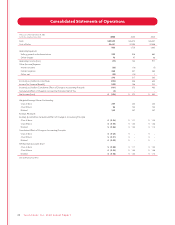Tyson Foods 2006 Annual Report Download - page 28
Download and view the complete annual report
Please find page 28 of the 2006 Tyson Foods annual report below. You can navigate through the pages in the report by either clicking on the pages listed below, or by using the keyword search tool below to find specific information within the annual report.
BUSINESS AND SUMMARY OF
NOTE 1SIGNIFICANT ACCOUNTING POLICIES
• Description of Business: Tyson Foods, Inc. (collectively, the
Company or Tyson), founded in 1935 with world headquarters in
Springdale, Arkansas, is the world’s largest processor and marketer
of chicken, beef and pork and the second largest food production
company in theFortune 500. Tyson produces a wide variety of
brand name protein-based and prepared food products marketed
in the United States and more than 80 countries around the world.
Tyson is a recognized market leader in the retail and foodservice
markets it serves. The Company has approximately 107,000
employees and more than 300 facilities and offices in 28 states
and 20 countries.
• Consolidation: The consolidated financial statements include
the accounts of all majority-owned and wholly-owned subsidiaries.
All significant intercompany accounts and transactions have been
eliminated in consolidation.
• Fiscal Year: The Company utilizes a 52- or 53-week accounting
period ending on the Saturday closest to September 30. The
Company’s accounting cycle resulted in a 52-week year for
years 2006 and 2005, and a 53-week year for year 2004.
• Reclassifications: Certain reclassifications related to items on
the Consolidated Statements of Operations have been made to
conform to current year presentations. The effect of the reclassifi-
cations was not material to the Company’s consolidated financial
statements.
• Cash and Cash Equivalents: Cash equivalents consist of invest-
ments in short-term, highly liquid securities having original maturities
of three months or less, which are made as part of the Company’s
cash management activity. The carrying values of these assets approxi-
mate their fair market values. The Company primarily utilizes a cash
management system with a series of separate accounts consisting
of lockbox accounts for receiving cash, concentration accounts funds
are moved to, and several “zero-balance” disbursement accounts
for funding of payroll, accounts payable and grower payments. As
a result of the Company’s cash management system, checks issued,
but not presented to the banks for payment, may create negative
book cash balances. These negative book cash balances are included
in trade accounts payable and other current liabilities. Checks
outstanding in excess of related book cash balances totaled approxi-
mately $246 million at September 30, 2006, and $332 million at
October 1, 2005.
• Accounts Receivable: The Company records trade accounts
receivable at net realizable value. This value includes an appropri-
ate allowance for estimated uncollectible accounts to reflect
any loss anticipated on the trade accounts receivable balances
and charged to the provision for doubtful accounts. The Company
calculates this allowance based on a history of write-offs, level
of past due accounts and relationships with and economic
status of the customers. At September 30, 2006, and October 1,
2005, the allowance for doubtful accounts was $8 million and
$9 million, respectively.
• Inventories: Processed products, livestock (excluding breeders) and
supplies and other are valued at the lower of cost (first-in, first-out)
or market. Livestock includes live cattle, live chicken and live swine.
Cost includes purchased raw materials, live purchase costs, growout
costs (primarily feed, contract grower pay and catch and haul costs),
labor and manufacturing and production overhead, which are related
to the purchase and production of inventories. Live chicken consists
of broilers and breeders. Breeders are stated at cost less amortiza-
tion. The costs associated with breeders, including breeder chicks,
feed and medicine, are accumulated up to the production stage
and amortized to broiler inventory over the productive life of
the flock using a standard unit of production.
Total inventory consists of:
in millions 2006 2005
Processed products $1,192 $1,210
Livestock 571 537
Supplies and other 294 315
Total inventory$2,057 $2,062
• Depreciation: Depreciation is provided primarily by the straight-
line method using estimated lives for buildings and leasehold
improvements of 10 to 39 years, machinery and equipment of
three to 12 years and other of three to 20 years.
• Long-Lived Assets: The Company reviews the carrying value of
long-lived assets at each balance sheet date if indication of impair-
ment exists. Recoverability is assessed using undiscounted cash
flows based on historical results and current projections of earnings
before interest and taxes. The Company measures impairment as
26 Ty s on Foods, Inc. 2006 Annual Report
Notes to Consolidated Financial Statements
























